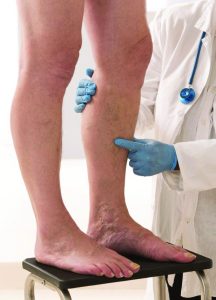By Federico M. Richter, MD
 Keeping our veins and body healthy is critical when trying to achieve longevity that’s not wreaked by illness and disorders. Even though most initial vein issues are superficial and if treated by experienced physicians, like those at the Vein Center at Erasers, most issues can be thwarted before posing significant problems.
Keeping our veins and body healthy is critical when trying to achieve longevity that’s not wreaked by illness and disorders. Even though most initial vein issues are superficial and if treated by experienced physicians, like those at the Vein Center at Erasers, most issues can be thwarted before posing significant problems.
Various forms of venous issues affect 25 million Americans. Their legs are swollen, achy and they have a heavy sensation. When our veins are working properly, they pump blood back to the heart. Valves in the veins are made to open and close in one direction if these valves or the wall of the veins are damaged, the blood is unable to work against gravity, and the result is a pooling of the blood in our legs. This pooling is called stasis and can present significant risks to our health.
Sometimes varicose veins are more of a cosmetic issue and poses little health concerns. This is usually noted in spider veins, which is when the tiny capillaries are damaged, but when the veins are damaged, this can cause varicose veins, which can lead to much more severe health issues. Neither of these should be taken lightly. A medical professional will be able to report whether or not your symptoms are superficial, or dangerous and in need treatment.
Because the veins and arteries balance each other out, when a person experiences chronic symptoms, it’s critical to see a physician. If the veins are damaged, it’s not unusual that the arteries are not pumping blood efficiently either. Chronic venous insufficiency must be treated to prevent further damage to your circulatory system and your overall health.
Both chronic and acute symptoms could be a sign or lead to a DVT (deep vein thrombosis). DVTs are life-threatening and should be treated immediately. Deep vein thrombosis is a blood clot in the veins that are formed deep in within the legs. Vascular malformations, varicose veins, pelvic tumors, surgeries, clotting disorders or sitting for long periods of time are some of the risk factors that go along with DVTs.
Celebrity and Pro Tennis player Serena Williams suffered a DVT, which led to a pulmonary embolism. Thankfully she had a successful emergency surgery that saved her life. Shortly after having heart surgery,
television host, Regis Philbin, also suffered from a DVT. He developed pain in his calf, and after further investigation, the clot was discovered. Fortunately, he too was treated and had a successful outcome.
Every year, over 2 million people are affected by deep vein thrombosis, and sadly over 200,000 of these cases end in death. These are grim statistics since the treatment is minimal and so readily available to patients. It’s unfortunate that there still seems to be more of a reactive process, than a proactive plan. Speaking to your physician is vital if you or a loved one have any of the venous symptoms or risk factors discussed above.
To alleviate your chances of DVT, it’s imperative to try and move your toes, ankles and do calf raises in your seat. If you can get up and walk around, that’s an important method to keep your blood flowing correctly back to your heart. If your trip is over 3 hours, or if you have venous insufficiency, wearing compression stockings is critical to keeping your vascular structures healthy.
If you have any health concerns or have had heart or peripheral vascular procedures, you should consult with your physician for a “Fitness to Fly or Travel” assessment.
About Federico M. Richter, MD
Dr. Richter focuses on the newest developments in minimally invasive vein treatments. Dr. Richter received his medical degree in Argentina in 2003 from Universidad Nacional de Cordoba . He then completed a year of general surgery and a 3-year Fellowship in vein and lymphatic disorders in 2007. As a venous and lymphatic medicine specialist, he is dedicated to treating varicose and spider veins and their underlying causes.
With over a decade of experience in the specialized medical field of diagnosing and treating vein disease, Dr. Richter was one of the first doctors to use lasers to treat a variety of vein diseases in Argentina. Certified by the American Board of Venous and Lymphatic Medicine and an active member of the American College Of Phlebology , Dr. Richter has also accumulated an impressive list of qualifications and educational accomplishments during the course of his career.
Vein Center at Erasers
941-907-3400
6050 53rd Ave. East (SR70), Suite A, Bradenton, FL 34203







